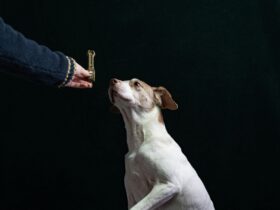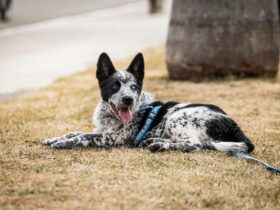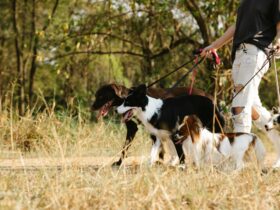Building a dog agility course in your backyard is a fun and rewarding project that can provide endless entertainment and exercise for both you and your dog. Whether you have a highly active dog that needs a challenge or you’re just looking for a new way to bond with your furry friend, a DIY agility course can be the perfect solution. This guide will walk you through the steps to create an effective, safe, and budget-friendly agility course right in your own backyard.
1. Understanding Dog Agility Training
Dog agility is a sport where a dog navigates through a series of obstacles, such as jumps, tunnels, and weave poles, guided by their handler. It not only provides physical exercise but also improves a dog’s mental acuity, agility, and responsiveness to commands. Agility training strengthens the bond between you and your dog, making it a popular choice for many dog owners.
2. Planning Your Backyard Agility Course
Before you start building, it’s important to plan the layout of your agility course. Consider the size of your backyard, the type of obstacles you want to include, and the skill level of your dog.
- Assess Your Space: Measure the available space in your backyard. While you don’t need a huge yard, ensure there’s enough room for your dog to run and maneuver between obstacles.
- Choose the Right Obstacles: The type of obstacles you include will depend on your dog’s experience and agility level. Common obstacles include jumps, tunnels, weave poles, and ramps.
- Safety First: Ensure that your backyard is safe for your dog. Remove any hazards, such as sharp objects or toxic plants, and make sure the ground is even.
3. Essential Equipment for a DIY Dog Agility Course
Here are the most common obstacles used in dog agility courses and how you can make them at home.
a. Jumps
Jumps are one of the most basic and essential elements of an agility course.
- Materials Needed: PVC pipes, adjustable connectors, or wooden dowels.
- How to Build: Use PVC pipes to create two vertical posts and one horizontal bar that your dog will jump over. The horizontal bar should be adjustable to different heights to accommodate your dog’s skill level.
- Tips: Start with a low bar and gradually increase the height as your dog becomes more comfortable.
b. Tunnels
Tunnels are fun and challenging for dogs, encouraging them to trust and follow your lead.
- Materials Needed: A large collapsible fabric tunnel (available at pet stores or online) or a DIY tunnel made from flexible plastic drainage pipe.
- How to Build: If using a fabric tunnel, simply set it up in your backyard. If building your own, cut the drainage pipe to the desired length, and secure it in place.
- Tips: Encourage your dog to go through the tunnel with treats and praise.
c. Weave Poles
Weave poles require precision and practice, making them one of the more challenging obstacles.
- Materials Needed: PVC pipes, wooden dowels, or broom handles.
- How to Build: Insert the poles into the ground in a straight line, with about 18-24 inches between each pole. The poles should be sturdy but flexible to avoid injury.
- Tips: Start with fewer poles and gradually increase the number as your dog improves.
d. A-Frame
The A-frame is an inclined ramp that challenges your dog’s climbing ability and balance.
- Materials Needed: Two wooden boards, hinges, and non-slip covering (like rubber matting or outdoor carpet).
- How to Build: Attach the two boards together with hinges to form an A-shape. Cover the boards with a non-slip material to prevent your dog from slipping.
- Tips: Ensure the incline is not too steep, especially for beginners.
e. Pause Table
The pause table teaches your dog to stop and stay in a specific position, usually sitting or lying down.
- Materials Needed: A sturdy wooden table or platform, non-slip covering.
- How to Build: Build or repurpose a small table with a non-slip surface where your dog can comfortably sit or lie down.
- Tips: Train your dog to stay on the table for a few seconds before moving on to the next obstacle.
f. Teeter-Totter (Seesaw)
The teeter-totter is a fun obstacle that tests your dog’s balance and confidence.
- Materials Needed: A long wooden plank, a fulcrum (such as a sturdy cylinder or block), non-slip covering.
- How to Build: Place the plank on the fulcrum to create a seesaw effect. Cover the plank with non-slip material to ensure your dog’s safety.
- Tips: Start by stabilizing the plank so it doesn’t move too much as your dog gains confidence.
4. Training Your Dog on the Agility Course
Once your agility course is set up, it’s time to start training your dog. Here’s how to do it:
- Start Slow: Introduce your dog to one obstacle at a time. Use treats and positive reinforcement to encourage your dog to complete each obstacle.
- Consistency is Key: Practice regularly to help your dog build confidence and improve their skills.
- Gradually Increase Difficulty: As your dog becomes more comfortable with the course, increase the difficulty by raising jump heights, adding more weave poles, or timing the course.
- Focus on Fun: Agility training should be fun for both you and your dog. Keep sessions short and positive, and never force your dog to do something they’re uncomfortable with.
5. Maintaining Your DIY Agility Course
To keep your course safe and functional:
- Regular Inspections: Check all obstacles regularly for wear and tear. Replace or repair any damaged parts immediately.
- Seasonal Adjustments: If you live in an area with extreme weather, consider storing certain obstacles during the off-season to prevent damage.
- Keep it Clean: Remove debris and ensure the area is free of hazards that could injure your dog.
6. Benefits of a DIY Dog Agility Course
Building a DIY agility course in your backyard has many benefits:
- Physical Exercise: Agility courses provide an excellent workout for your dog, helping them burn off excess energy.
- Mental Stimulation: Navigating the obstacles challenges your dog’s mind and keeps them mentally sharp.
- Bonding Time: Working together on the agility course strengthens the bond between you and your dog.
- Customization: You can tailor the course to your dog’s specific needs and skill level.
- Cost-Effective: Building your own course is much cheaper than purchasing professional-grade equipment or attending agility classes.
7. Conclusion
Creating a DIY dog agility course in your backyard is a fantastic way to engage your dog in a fun and stimulating activity. By following this guide, you can build a course that is safe, challenging, and tailored to your dog’s needs. Not only will your dog benefit from the physical and mental exercise, but you’ll also enjoy the satisfaction of watching your dog master the obstacles you’ve built with your own hands. So grab some materials, set up your course, and start enjoying the many benefits of dog agility training right at home!











Leave a Reply